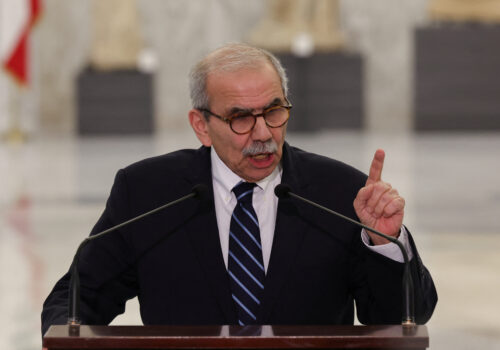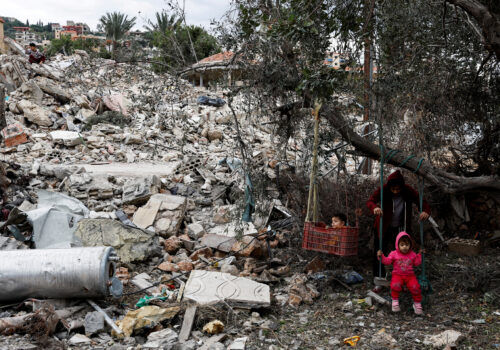Is Israel laying the groundwork to stay in Lebanon and defy a second withdrawal deadline?
The Israeli military has already missed one deadline to pull its forces out of south Lebanon at the end of a sixty-day ceasefire that fell on January 27, and now there are concerns that the Israelis may extend their presence beyond a second withdrawal date set for February 18.
Fueling such speculation are reports that the Israelis are constructing what sources with the United Nations (UN) peacekeeping mission in south Lebanon, known by the acronym UNIFIL, say are “semi-permanent Forward Operating Bases” (FOBs) on hilltops close to the Blue Line, the UN name for Lebanon’s southern border.
Israel has provided no indication of whether it will continue to stay beyond February 18, but it has repeatedly accused the Lebanese Armed Forces (LAF) of failing to disarm Hezbollah in the southern border district and fully deploy across the area in accordance with the ceasefire agreement that commenced on November 27. Lebanon has said that the LAF cannot deploy in all villages and towns until the Israeli military has left. Since the ceasefire began, the LAF has significantly increased its presence in the area south of the Litani River (which lies between three and twenty-eight kilometers from the Blue Line) in what the UN has described as a demonstration of “resolve.” The LAF also has taken control of some former Hezbollah facilities in the southern border district, including a massive underground tunnel network, named Imad 4, that was showcased in a Hezbollah video last August.
During the sixty-day ceasefire and since then, the Israeli military has continued operations to uncover and destroy Hezbollah infrastructure and seize weapons and ammunition along a narrow strip adjacent to the border. The Israelis also destroyed hundreds of houses, places of worship, roads, and electricity and water infrastructure in what many Lebanese interpret as a deliberate policy to create a belt of territory adjacent to the border that is all but uninhabitable.
Nevertheless, on the day the ceasefire ended, tens of thousands of Lebanese flocked back to their homes, despite warnings from the Israeli military to stay away. On that day, twenty-two Lebanese were killed and 124 wounded by Israeli fire as they marched toward their homes. While the desire to return to their homes was genuine, there was a degree of organization behind the mass march, with residents brandishing new Hezbollah flags and portraits of “martyrs” killed during the recent conflict.
SIGN UP FOR THIS WEEK IN THE MIDEAST NEWSLETTER
Not only have the Israelis been dynamiting villages, uprooting olive trees, and building semi-permanent outposts on the loftier reaches of the southern border district, but they also have launched a program of defoliation to destroy ground cover along the Lebanese side of the Blue Line. Three separate UNIFIL sources told me that the Israelis have engaged in unusual aerial activity since the weekend of January 25-26. A small prop plane has been spotted flying at low altitude and disseminating a defoliant agent along a swathe of Lebanese territory immediately adjacent to the Blue Line. A UNIFIL spokesman confirmed the flights and said that the peacekeepers had been able to identify with their “limited capabilities” that the substance was a chemical herbicide.
“It’s something to stop the vegetation growing in the near future. It gives the Israelis a better view across the area,” the spokesman said.
There is a precedent for such actions by the Israeli military. Since 2014, Israel has been spraying herbicides on the Palestinian side of the Gaza border to destroy ground cover that could be used by militants to approach the security fence. According to Israeli researchers, the flights have also caused damage to Palestinian farmers’ crops. The low-level flights along the Blue Line appear to have the same goal as in Gaza, destroying all vegetation that could be used by Hezbollah to cover movement along the border. In the past, Hezbollah fighters have used the dense undergrowth of bushes and Mediterranean oak to mask tunnelling activities and to observe Israeli troop movements on the other side of the border. However, Lebanese farmers have crops, mainly tobacco and olive trees, close to the Blue Line where the flights have occurred that could be affected by the chemical agent.
If the Israeli army does remain in Lebanon after February 18, it will pose a significant dilemma for Hezbollah. The thirteen-month war with Israel has shattered Hezbollah’s deterrence against its long-standing enemy. Israel, frankly, is no longer scared of Hezbollah, and the mutual deterrence that maintained a tense calm along the Blue Line from their 2006 war until the outbreak of hostilities in October 2023 is well and truly over. On January 30, Israel shot down an alleged Hezbollah drone flying over south Lebanon in the first such incident since the November 27 ceasefire began. In retaliation, Israel staged that night a series of air strikes against Hezbollah targets in the Bekaa Valley. Such a response would have been unthinkable before October 2023 when Israel confined its anti-Hezbollah operations to Syrian territory rather than Lebanon to reduce the risk of escalation and possible war.
UNIFIL sources told me that the Israelis are building the semi-permanent FOBs in at least five locations: one on the Blue Line at Labboune south of Naqoura where UNIFIL’s headquarters are located, a second on Jabal Blat opposite the Israeli settlement of Zarit and the location of a prominent Israeli compound during the years of occupation, two more positions on the adjacent hills of Tallet Ezziyeh and Jabal Aweida near the Lebanese border village of Kfar Kila, and a fifth on Tallet Hamames facing the Israeli town of Metulla.
The outposts include cement structures, contain technological equipment, and are protected by Hesco blast barriers, according to UNIFIL sources. Israel appears to be signaling that the outposts are necessary to allow the Israeli military to dominate the high ground along the Blue Line and to prevent Hezbollah from returning to the border. However, such an argument would be somewhat specious, and the decision to construct and man the outposts is clearly provocative. Israel enjoys saturation air coverage over south Lebanon and does not require a footprint on the ground for observation purposes over a relatively limited stretch of the border. It also has shown no hesitation in the past two months to launch attacks against any suspected Hezbollah movements it detects both north and south of the Litani. Furthermore, the Israeli army is also planning to build a string of new military compounds on the Israeli side of the border between the fence and towns and settlements to provide better protection for residents.
Nevertheless, if Israel stations troops in the outposts beyond the February 18 deadline, Hezbollah will have to decide whether or not to launch attacks against them. If Hezbollah attacks, Israel is likely to respond disproportionately, possibly by resuming air strikes against targets in the southern suburbs of Beirut or assassinations of senior cadres. If Hezbollah does nothing, it will inevitably undermine the party’s resistance credentials and provide ammunition to the group’s opponents in Lebanon who want it disarmed. After all, if Hezbollah refrains from confronting Israeli occupation, what is the point of it continuing to carry weapons?
One possibility apparently under consideration, according to sources close to Hezbollah, is to mount deniable operations in which attacks are claimed by previously unknown groups to convey the impression they are acts of grassroots resistance by residents of south Lebanon. However, given Israel’s bullish mood, it is unlikely to turn the other cheek to such attacks even if they go unclaimed by Hezbollah.
Nicholas Blanford is a nonresident senior fellow with the Atlantic Council’s Middle East Programs, a Beirut-based consultant, and a defense and security correspondent for IHS/Jane’s.
Further reading
Wed, Jan 29, 2025
Lebanon’s prime minister-designate is unlikely to confront Hezbollah
MENASource By
Given Lebanon’s dire postwar economic state, Nawaf Salam is highly unlikely to risk escalating internal conflict during his premiership.
Tue, Jan 21, 2025
The quest ahead for Lebanon’s new president: Secure a modern statehood
MENASource By Frederic C. Hof
Aoun knows what must be done to stabilize the Lebanon-Israel frontier. But the long game he wishes to contest and win centers on Lebanese statehood.
Thu, Dec 5, 2024
A ceasefire happened in Lebanon, but Israel seems to have missed the memo
MENASource By Nicholas Blanford
Within hours of the 4 a.m. ceasefire coming into force, Israeli troops inside Lebanon opened fire at vehicles as tens of thousands of Lebanese who had earlier fled the fighting attempted to return to their homes.
Image: Israeli soldiers stand near Lebanese detainees at the Israeli-Lebanese border, as seen from northern Israel, after a ceasefire between Israel and Hezbollah took effect, January 27, 2025. REUTERS/Ronen Zvulun TPX IMAGES OF THE DAY


